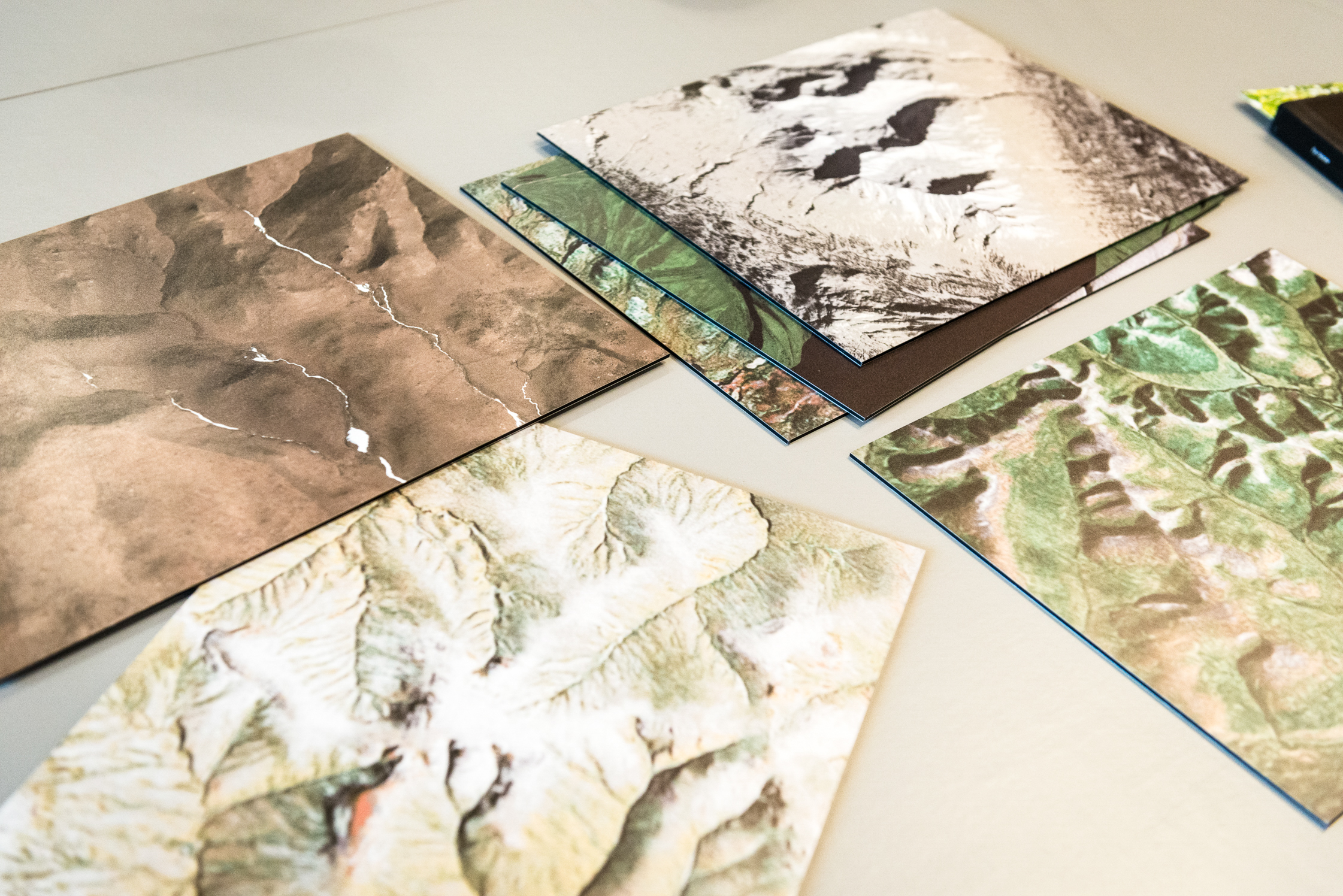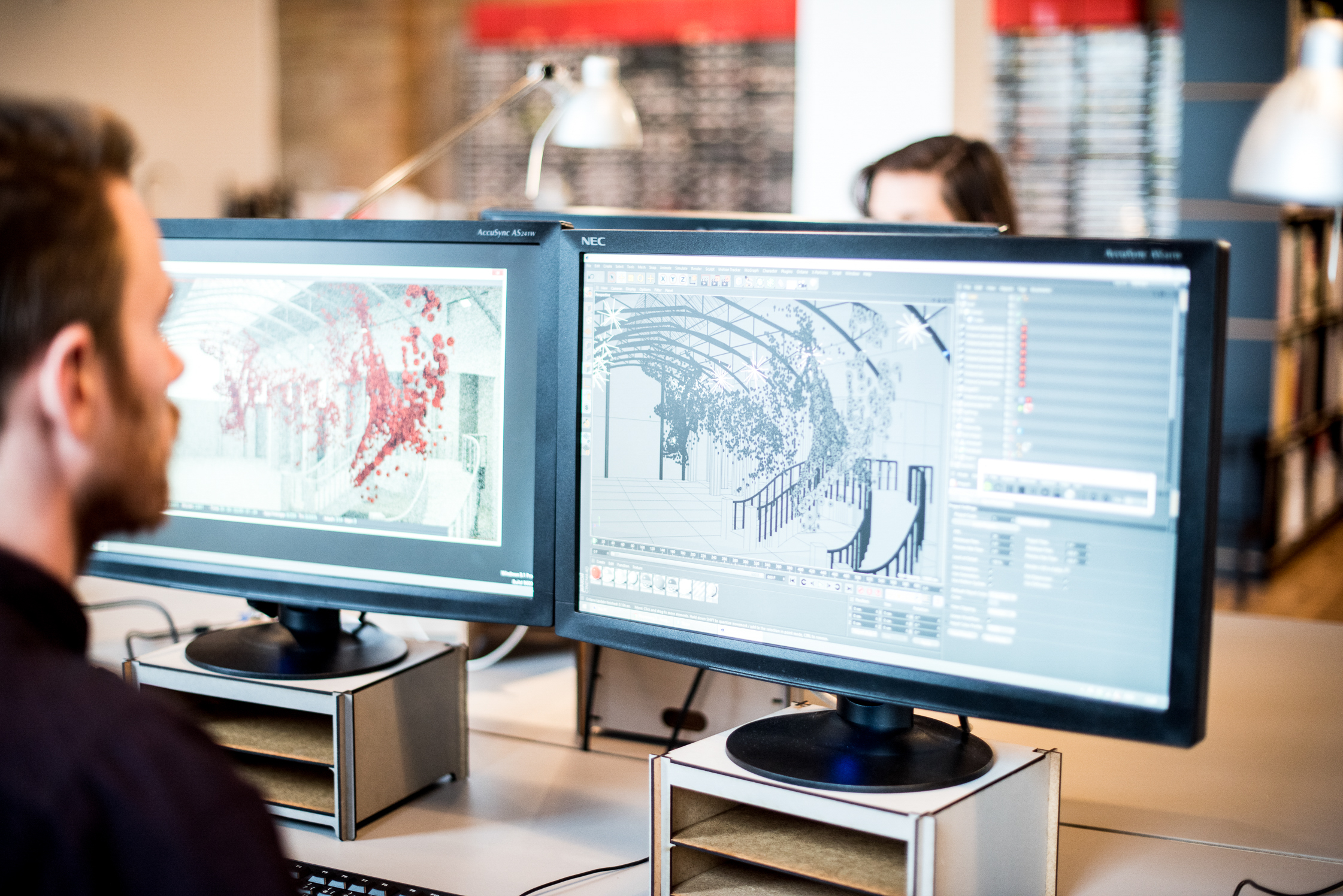Berlin studio onformative blurs the line between design and art. On its Friedrichshain premises, visual worlds and sculptures emerge as visions of the future.
A dark room. A large, colourfully lit orb, like something from a science fiction film. The surface of the orb brings to mind lava or liquid lead; flickering, pulsating, giving life to itself – it’s like standing in front of a miniature version of the sun. As a visitor enters the room, something curious transpires: the blobs and spirals move quicker on the sphere’s surface, pull away from the visitor and back towards them again. The orb reacts to movement and noise; it communicates, building a relationship with its environment.
The stunning and emotive room installation ANIMA Iki is a tangible vision of the future. The moving surface structure is projected from inside the sculpture out of a transparent shell by a projector, creating the illusion of the object floating freely in space. The installation was developed by the Berlin studio onformative and was originally conceived for the Amsterdam Dance Event music festival. Reason enough to pay them a visit. We meet onformative founders Cedric Kiefer and Julia Laub in their office and workspace in an industrial complex in Berlin Friedrichshain. For six years, the duo and their team have worked on their distinctive visions of art and design. Their particular approach is known as ‘generative design’ and uses code to create impressive abstract imagery. Process is key here, as the designer comes to a conclusion after adjusting their code repeatedly.



Cedric and Julia no longer see themselves as just graphic designers or creators. They drive their work far past the boundaries of design and styling, and blur the lines between other creative fields such as visual arts and music. For them, an important part of their work is deciding whether the code will generate a pattern on the computer screen or, for example, whether it will control a light installation: “We deal with topics that interest us and then work on them in a very different way. When we begin to take a closer look at a topic we stay open to what the result can and will be,” explains Cedric. “It’s an open and experimental process. We’re not so much guided by the medium itself.” Julia adds, “We’re especially interested in scientific subjects, nature-based topics and current issues. There comes a point when we say – ‘That’s what we want to understand and work with’. Then we choose the right medium to express it.”




Both founders studied communication design and tackled the theme of generative design from early on. It was this fascination with rule-based design and design forms which brought the duo together. Julia had contacted Cedric as part of a book project on the subject, also the basis for her thesis. The book has become one of the key reference works on the subject, and the term ‘generative design’ proving particularly influential in Germany. Cedric was first drawn to the subject during his studies at HfG Karlsruhe, just stone’s throw away from the Centre for Art and Media. From their first point of contact, a prolific Skype exchange developed between the two, which they later gave vision to in a poster. The duo’s first face-to-face meeting came a year later as part of the book release at the Frankfurt Book Fair, a meeting that also brought about the decision to found a studio together in Berlin.
A closer look around the onformative studio reveals just how the playful, experimental and inventive team follow their process-based approach. At first glance, the rooms are tidy and almost bare. But upon closer inspection there are multitude of imaginative and endearingly nerdy details to discover. Just like the discarded split-flap display from a train station, which is emblazoned on the desks and shelves. It can be controlled from a website and displays upcoming appointments or at the push of a button, spits out an answer to the reasonable question of where the team should go to lunch.

“It’s about not being satisfied with what has already been done.” – Cedric
The workshop and studio space are connected to the offices, where shelves house boxes full of tools, boards and cables, surround a workbench in the middle of the room. Here the team develops and works on its latest installation: a light sculpture based on computerized pillars that release or withhold their individual elements of light. In the future, the columns will be produced in a series, so that they can depict patterns or writing alongside one another. With all of these ideas and creations, curiosity is never far from their work. “It’s about not being satisfied with what has already been done. But to question, develop and newly combine. An object that was originally designed to produce music can, for example, also be used to control robots, which could then shape a three-dimensional sculpture.”







To better understand onformative’s work and ethos, it’s worthwhile to look at roots of generative design. Artists have always worked with the idea of using a self-developed set of rules to create a work of art – whether it be through technical design or mathematical formula. In the sixties, the artist and mathematician Gerog Nees, a pioneer of computer art, developed graphics and sculptures that were generated by means of a computer code. Avant-garde composers like John Cage or Steven Reich realized similar ideas in music. As computers continued to develop into the ’80s and especially the ’90s, these pioneers anticipated that ‘media art’ or ‘digital art’ was to become its own creative movement of computer and code-based art. Just as technical possibilities have developed so have things evolved, explains Julia, “What was previously seen as exceptional art, is now firmly integrated into everyday design. Working with code and rule-based systems has become one of many tools for designers, so that topics and content are significant again today.”


In recent years, generative methods in design have been increasingly used to render complex data and translate them into fascinating graphic designs. This is a challenge onformative takes on with commissioned work for Levi’s and Porsche. “Many companies and customers are sitting on a mountain of data that, at first glance, looks terribly boring but within which a lot of exciting stories hide,” explains Cedric. “Nutting things out and interpreting artistically are tasks that excite us.” onformative, however, devotes only part of its creative energy to this commissioned work. The team exerts around half of its energy into free, self-launched projects. True to Cedric’s motto ‘away from the screen and into the room’, onformative has developed its approach consistently in recent years and, similar to artistic generations before them, has been applying it limitlessly. Cedric says then, “The concepts and principles can be applied to every medium. The exciting thing about the physical aspect is that the interaction with objects triggers another set of emotions.” Bringing us right back to ANIMA Iki, the animated orb.




This is just one of the many exciting works that Cedric and Julia have been working on in recent months. At the end of the interview they give us an insight into the development of their latest digital artworks. There is, for example, a project involving a program to make the physical laws of rivers visible. For this, the studio works closely with a team of sound designers who create the installations’ sounds by translating the program’s code, and using them as the basis for electronic music. Or the program that recognizes faces in the surface structures of Google Maps satellite images. On top of this, there’s the completely abstract work from onformative, created in collaboration with the Frankfurt-based avant-garde Forsythe Dance Company. The project brings dancers to react to computer calculated impulses; experimenting in a new field connecting dance and technology.
Pathfinder: Digital Dance




All in all, it’s an impressive portfolio. onformative never stays still and repeatedly questions the limits of its own creation. This studio is a wonderful example of the kind of energy and creativity released by limitless thinking – and how much fun that can be.
We thank Cedric and Julia for the fascinating interview and the insight into their work space. Learn more about onformative’s work, and find out what’s coming up next here.
Dive into our archive and meet more friends from Berlin.
Photography:Daniel Müller
Interview: Hanno Stecher





